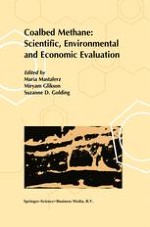1999 | OriginalPaper | Buchkapitel
Source and Timing of Coal Seam Gas Generation in Bowen Basin Coals
verfasst von : S. D. Golding, K. A. Baublys, M. Glikson, I. T. Uysal, C. J. Boreham
Erschienen in: Coalbed Methane: Scientific, Environmental and Economic Evaluation
Verlag: Springer Netherlands
Enthalten in: Professional Book Archive
Aktivieren Sie unsere intelligente Suche, um passende Fachinhalte oder Patente zu finden.
Wählen Sie Textabschnitte aus um mit Künstlicher Intelligenz passenden Patente zu finden. powered by
Markieren Sie Textabschnitte, um KI-gestützt weitere passende Inhalte zu finden. powered by
Coal seam gases collected from Bowen Basin cores have moderately negative methane carbon isotope compositions (−51 ± 9 per mil) which overlap the published range for Australian coal seam methane of −60 ± 11 per mil. No systematic relationship between coal rank and methane δ13C value is apparent. A thermogenic origin for methane has been assigned when its carbon isotope composition is heavier than −60 per mil, although biogenic methane generated in closed systems may have similar δ13C values from −60 to −40 per mil depending on the methanogenic pathway and the carbon isotope composition of the source. Subordinate inputs from biogenic methane could account for some of the isotopic variability of the desorbed methane; however, a good correlation between desorbed methane volumes and bitumen/pyrobitumen content suggests that much of the methane sorbed in the coal was produced by secondary cracking of bitumen.Bowen Basin methane δ13C values are typically some 20 to 30 per mil lighter than vitrinite and inertinite δ13C values. Carbon isotope compositions of vitrinites and inertinites in sub-bituminous coals become less negative with increasing rank as a result of the preferential loss of the lighter isotope of carbon during maturation. Vitrinite reflectance and maceral carbon isotope compositions often display an anomolous trend for coals in the high to medium volatile bituminous rank as a result of the presence of adsorbed isotopically light methane Thus, a sharp distinction in isotope systematics distinguishes coals that are within peak oil generation from those that are at or below the threshold of oil generation. Bitumen may show equal or higher concentrations within inertinite cell cavities as in vitrinite cleats and affect carbon isotope compositions of vitrinites and inertinites.Compositional data for desorbed coal seam gases from the Bowen Basin show that ethane and the other wet gases are a minor component. On the other hand, high concentrations of wet gases are produced during pyrolysis of coals. This discrepancy between the proportion of wet-gas components produced during pyrolysis and that observed in many naturally matured coals may be the result of preferential migration of wet gas components. Alternatively, the wet gas components may be thermally cracked to methane at higher maturation levels or diluted by additional methane produced by secondary cracking of bitumen.Previous vitrinite reflectance and clay mineral diagenesis studies indicate that thermal maturation of the Late Permian coals in the central and northern Bowen Basin occurred largely as a result of a short-lived hydrothermal event in the Late Triassic rather than during maximum burial in the Middle Triassic as previously thought. Textural relationships at a variety of scales and the observation that coals in proximity to Cretaceous intrusions are highly mineralised with carbonates and sulfides suggest several periods of hydrothermal activity. It is concluded, therefore, that thermal maturation of coal in the Bowen Basin to form oil and gas was caused predominantly by transient thermal and fluid flow events in the Mesozoic. High temperatures associated with transient hydrothermal events and the potential for secondary cracking of bitumen may provide an explanation for anomolous gas compositions and isotope systematics.
